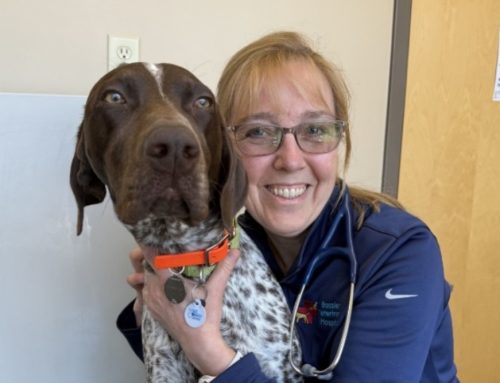If your beloved companion is uncomfortable or experiencing any pain, you’d think you would know. After all, your pet is attached to you at the hip when you’re home, so picking up on their discomfort should be easy, right? Unfortunately for you and your furry pal, cats and dogs are masters at hiding signs of illness, injury, and disease, so spotting pain and procuring treatment for your best friend can be tough. Some pets are so skilled at disguising their discomfort that their pain level can progress for months until clearly visible signs appear. Cats and dogs can also adapt to pain, adjusting their typical behavior to accommodate their discomfort, while still performing their usual activities. For example, a cat suffering from an odontoclastic resorptive lesion may skip eating dry food, and avoid dental pain by eating canned food, or may eat on only one side of their mouth.
Pets are remarkably skilled at handling pain, but no pet owner wants to see their furry family member suffer. So, commit the following 10 signs of pain in pets to memory, so you can spot tenderness at the first ache, and limit their suffering.
#1: Your pet’s appetite has decreased
If your furry pal isn’t creating a drool puddle, or rushing to the empty food dish as you fill it, your pet may be painful, and reluctant to eat. However, pets with significant dental disease still manage to eat, despite loose teeth, irritated gums, and periodontal infection. Monitor your pet’s eating and drinking habits to ensure they remain the same, as a change in the amount or behavior (i.e., chewing on one side of the mouth, or lying down to eat) can indicate pain.
#2: Your cat is missing the litter box
While your cat can miss the litter box for a host of reasons, pain can be a major factor. Whether your feline friend is suffering from idiopathic cystitis, a urinary tract infection, or osteoarthritis, elimination can be painful, causing your cat to seek other outlets away from the box associated with pain.
#3: Your pet doesn’t want to engage in their favorite activities as much as usual
If you are having an off day and suffering from a backache or knee pain, you’re much less likely to engage in your favorite cardio workout or sport, and your pet is no different. Your arthritic cat is unlikely to enjoy pouncing on a feather wand, while your achy pooch won’t chase a ball across the backyard.
#4: Your pet refuses to jump onto furniture
A key indicator that your pet is feeling discomfort is their refusal to jump onto their favorite chair or spot on the couch. Stairs are an excellent alternative, and should always be available for long-bodied, short-legged breeds, to help spare them from back issues.
#5: Your dog pants more than usual
Heart and respiratory rates can skyrocket with pain, and are clues that your pet is suffering. If you notice your pooch panting more than normal, especially at rest, they may be uncomfortable.
#6: Your cat’s hair coat is scruffy from lack of self-grooming
Cats are notoriously finicky groomers, and prefer to keep themselves looking sleek and shiny. If your cat’s hair coat is scruffy and unkempt because they are not grooming, they may be too sore to contort their body to groom.
#7: Your pet is irritable when petted or touched in a particular area
While your pet may be an angel who never snaps, growls, hisses, or swats at you, petting a sore spot may irritate them. If you stumble across a tender area while petting or grooming, and your pet reacts in an out-of-the-ordinary manner, they are likely suffering from a pain-related issue.
#8: Your pet sleeps more than normal
When you don’t feel well, you sleep more than usual, and your pet does the same. Painful, uncomfortable pets sleep more to avoid the discomfort of everyday activities, and to give their bodies a chance to heal and recuperate.
#9: Your pet avoids the stairs
Stairs are next to impossible to navigate when you are suffering from painful arthritis, hip dysplasia, or elbow dysplasia. While some pets can climb stairs well, since they can use their powerful hind legs to push off, pets whose hind legs are weak and stiff cannot. The same holds true for the reverse—going down stairs is easier for pets with strong front legs, but elbow and wrist pain can make the descent more challenging.
#10: Your pet excessively licks or chews at a particular area

In an attempt to soothe an achy area, your pet may excessively lick or chew a joint or bony prominence, resulting in development of a lick granuloma over the affected area. Licking at a sore area can become an obsessive behavior that may continue after the source of pain is gone, and can be difficult to resolve.
While limping and lameness are obvious pain indicators in pets, other signs are more subtle and challenging to detect. If you notice any of the above pain signals, schedule a comprehensive evaluation of your pet with Dr. Bassler, to find the source of their soreness.








Leave A Comment